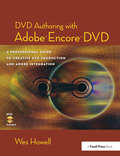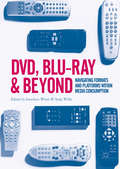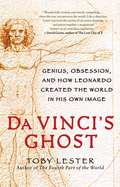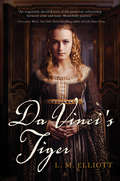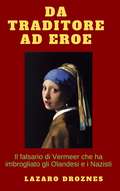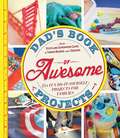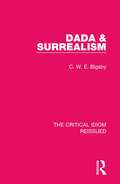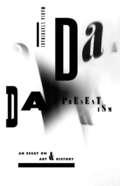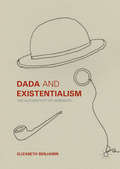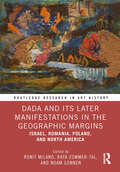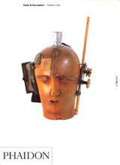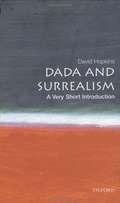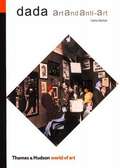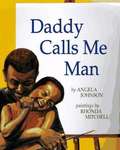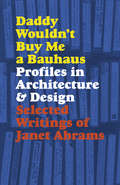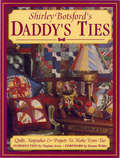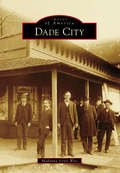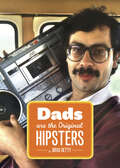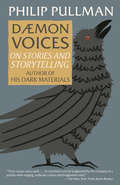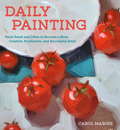- Table View
- List View
DVD Authoring with Adobe Encore DVD: A Professional Guide to Creative DVD Production and Adobe Integration
by Wes HowellExpand your creative ability by mastering the software tools. "DVD Authoring with Adobe Encore DVD" covers the toolset in a manner that demonstrates real-world application. The downloadable resources with source material walks you through the process. You will learn how to avoid common pitfalls and learn about the entire DVD authoring workflow.
DVD, Blu-ray and Beyond: Navigating Formats and Platforms within Media Consumption
by Andy Willis Jonathan WrootThis book demonstrates, in contrast to statistics that show declining consumption of physical formats, that there has not been a mass shift towards purely digital media. Physical releases such as special editions, DVD box-sets and Blu-Rays are frequently promoted and sought out by consumers. And that past formats such as VHS, Laserdisc and HD-DVD make for sought-after collectible items. These trends are also found within particular genres and niche categories, such as documentary, education and independent film distribution. Through its case studies, this collection makes a distinctive and significant intervention in highlighting the ways in which the film industry has responded to rapidly changing markets. This volume, global in scope, will prove useful to those studying the distribution and exhibition of films, and the economics of the film industry around the world.
Da Vinci (Getting to Know the World's Greatest Artists)
by Mike VeneziaA simple biography of Leonardo de Vinci for younger readers
Da Vinci's Ghost: Genius, Obsession, and How Leonardo Created the World in His Own Image
by Toby LesterIn Da Vinci's Ghost, critically acclaimed historian Toby Lester tells the story of the world’s most iconic image, the Vitruvian Man, and sheds surprising new light on the artistry and scholarship of Leonardo da Vinci, one of history’s most fascinating figures.Deftly weaving together art, architecture, history, theology, and much else, Da Vinci's Ghost is a first-rate intellectual enchantment.”—Charles Mann, author of 1493 Da Vinci didn’t summon Vitruvian Man out of thin air. He was inspired by the idea originally formulated by the Roman architect Vitruvius, who suggested that the human body could be made to fit inside a circle, long associated with the divine, and a square, related to the earthly and secular. To place a man inside those shapes was to imply that the human body could indeed be a blueprint for the workings of the universe. Da Vinci elevated Vitruvius’ idea to exhilarating heights when he set out to do something unprecedented, if the human body truly reflected the cosmos, he reasoned, then studying its anatomy more thoroughly than had ever been attempted before—peering deep into body and soul—might grant him an almost godlike perspective on the makeup of the world. Written with the same narrative flair and intellectual sweep as Lester’s award-winning first book, the “almost unbearably thrilling” (Simon Winchester) Fourth Part of the World, and beautifully illustrated with Da Vinci's drawings, Da Vinci’s Ghost follows Da Vinci on his journey to understanding the secrets of the Vitruvian man. It captures a pivotal time in Western history when the Middle Ages were giving way to the Renaissance, when art, science, and philosophy were rapidly converging, and when it seemed possible that a single human being might embody—and even understand—the nature of the universe.
Da Vinci's Tiger
by L. M. ElliottFor fans of rich and complex historical novels like Girl with a Pearl Earring or Code Name Verity, Laura Malone Elliott delivers the stunning tale of real-life Renaissance woman Ginevra de' Benci, the inspiration for one of Leonardo da Vinci's earliest masterpieces. The young and beautiful daughter of a wealthy family, Ginevra longs to share her poetry and participate in the artistic ferment of Renaissance Florence but is trapped in an arranged marriage in a society dictated by men. The arrival of the charismatic Venetian ambassador, Bernardo Bembo, introduces Ginevra to a dazzling circle of patrons, artists, and philosophers. Bembo chooses Ginevra as his Platonic muse and commissions a portrait of her by a young Leonardo da Vinci. Posing for the brilliant painter inspires an intimate connection between them, one Ginevra only begins to understand. In a rich and vivid world of exquisite art with a dangerous underbelly of deadly political feuds, Ginevra faces many challenges to discover her voice and artistic companionship--and to find love.
Da traditore a eroe: Il falsario di Vermeer che ha imbrogliato gli Olandesi e i Nazisti
by Lázaro DroznesL'incredibile storia di Han van Meegeren, il pittore olandese che ha prodotto i falsi di Vermeer, ha ingannato gli stessi olandesi, ne ha venduto uno a Herman Goering e alla fine ha dovuto confessare il suo crimine per salvarsi dalla pena di morte, accusato di alto tradimento. Dopo il processo è diventato un eroe nazionale per aver imbrogliato i nazisti. Queste confessioni furono un terremoto nella comunità pittorica dell'Olanda e del mondo intero, poiché le sue falsificazioni erano state accettate all'unanimità e, una di esse, il "Cristo in Emmaus", fu considerata il miglior Vermeer di tutte. Questa finzione, basata su eventi reali, ci porta a riflettere sul concetto di autenticità nell'arte e sulla validità dei concetti tradizionali di verità e bellezza: un dipinto non è più bello quando viene scoperto come falso? Perché le persone perdono interesse per un'opera d'arte se non è autentica? Perché la natura umana non ci permette di godere dell'estetica di un falso Vermeer che ci piaceva prima di scoprire che fosse un falso? Il business dell'arte è una bufala?
Dad's Book of Awesome Projects: From Stilts and Super-Hero Capes to Tinker Boxes and Seesaws, 25+ Fun Do-It-Yourself Projects for Families
by Mike AdamickIt's time for serious family fun!Get ready to take playtime to the next level with Dad's Book of Awesome Projects! Inside, you;ll find step-by-step instructions and photographs detailing projects so imaginative and fun, no one will complain about turning off the TV. From wooden "swords" to slay the most vicious of dragons to circus stilts that will send you soaring to new heights, these projects are sure to spark everyone's creative spirit. And the fun doesn't stop there! This book shows you and your kids how to build:Comic book shoesRope swingsHomemade goo slimeEggshell cupcakesOl'-fashioned fruit crate scooterBest of all, each of these activities can be tossed together with items around the house or with inexpensive supplies from the hardware store. With 25 DIY projects and crafts, Dad's Book of Awesome Projects will reveal just how awesome it is to be a dad!
Dada & Surrealism (The Critical Idiom Reissued #22)
by C. W. BigsbyFirst published in 1972, the work provides an introduction to Dada and Surrealism. It explores the two movements and their cultural significance. It also looks at those who called themselves Dadaists and Surrealists, including their aims and achievements. In doing so, the book identifies the meaning that the two terms have acquired, which is often remote from the claims advanced by the chief adherents of each movement. This book will be a valuable resource to those studying Dada and Surrealism and its relationship to modern literature.
Dada Presentism: An Essay on Art and History
by Maria StavrinakiDada is often celebrated for its strategies of shock and opposition, but in Dada Presentism, Maria Stavrinaki provides a new picture of Dada art and writings as a lucid reflection on history and the role of art within it. The original (Berlin-based) Dadaists' acute historical consciousness and their modern experience of time, she contends, anticipated the formulations of major historians such as Reinhart Koselleck and, more recently, François Hartog. The book explores Dada temporalities and concepts of history in works of art, artistic discourse, and in the photographs of the Berlin Dada movement. These photographs--including the famous one of the First International Dada Fair--are presented not as simple, transparent documents, but as formal deployments conforming to a very concrete theory of history. This approach allows Stavrinaki to link Dada to more contemporary artistic movements and practices interested in history and the archive. At the same time, she investigates what seems to be a real oxymoron of the movement: its simultaneous claim to the ephemeral and its compulsive writing of its own history. In this way, Dada Presentism also interrogates the limits between history and fiction.
Dada and Existentialism: The Authenticity of Ambiguity
by Elizabeth BenjaminOfferingnew critical approaches to Dada as quintessential part of theAvant-Garde, Dada and Existentialism: the Authenticity of Ambiguity reassessesthe movement as a form of (proto-) Existentialist philosophy. Dada isoften dismissed as an anti-art movement with a merely destructive theoreticalimpetus. French Existentialism is often condemned for its perceived quietistimplications. However, closer analysis reveals a preoccupation with philosophyin the former and with art in the latter. Moreover, neither was nonsensical ormeaningless; both reveal a rich individualist ethics aimed at the ameliorationof the individual and society. The first major comparative study of Dada andExistentialism, this text contributes new perspectives on Dada as movement,historical legacy, and field of study. Analysing Dada works throughExistentialist literature across the themes of choice, alienation,responsibility, freedom and truth, the text posits that Dada and Existentialismboth advocate the creation of a self that aims for authenticity throughambiguity.
Dada and Its Later Manifestations in the Geographic Margins: Israel, Romania, Poland, and North America (Routledge Research in Art History)
by Ronit Milano Raya Zommer-Tal Noam GonnenThis volume focuses on the unstudied geographic margins of Dada, delving into the roots of Dada in Israel, Romania, Poland, and North America.Contributors consider some of the practices and experiments that were conceived a century ago, surfaced in art throughout the twentieth century, and are still relevant today. Unearthing its Israeli origins, examining Dadaist expressions in Poland, and shedding light on overlooked facets of Dadaist art in Romania and North America, the authors cast a spotlight on the less-explored geographical peripheries of Dada. The book is organized around four thematic trajectories—space, language, materiality, and reception—which are dissected through the lens of micro-histories. Recognizing the continuing validity of questions raised by Dadaist artists, this volume argues that Dada persists as an ongoing endeavor—a continual reexamination of the fundamental tenets of art and its ever-evolving potential manifestations.The book will be of interest to scholars working in art history, modernism, and history of the twentieth and twenty-first centuries.
Dada and Surrealism (Art and Ideas Ser.)
by Matthew Gale Etienne Menanteau Dagmar Welle-SkittDada and Surrealism were two revolutionary art movements which emerged in response to the events and ideas of the early twentieth century. Dada, characterized by found objects and works made according to the laws of chance, was anarchic and anti-art. In part a reaction to the senseless destruction of World War I, it questioned all accepted values. Surrealism, in contrast, was a more defined movement which evolved in the 1920s as artists and writers took up Freud's concept of the unconscious to undermine traditional conventions. By use of such techniques as automatism, artists sought to represent in concrete terms the imagery of dream and fantasy. In this clear and lively account, Matthew Gale explores the work of a wide range of artists - from Marcel Duchamp and Raoul Hausmann to Max Ernst, René Magritte and Salvador Dali - and uses paintings, collages, sculptures, assemblages, photographs, photomontages, film stills and graphics to illustrate the rich variety of Dada and Surrealist art. This essential introductory book is the first to reproduce many of these works in colour.
Dada and Surrealism: A Very Short Introduction
by David HopkinsThe avantgarde movements of Dada and Surrealism continue to have a huge influence on cultural practice, especially in contemporary art, with its obsession with sexuality, fetishism, and shock tactics. In this new treatment of the subject, Hopkins focuses on the many debates surrounding these movements: the Marquis de Sade's Surrealist deification, issues of quality (How good is Cali?), the idea of the "readymade," attitudes towards the city, the impact of Freud, attitudes to women, fetishism, and primitivism. The international nature of these movements is examined, covering the cities of Zurich, New York, Berlin, Cologne, Barcelona, Paris, London, and recently discovered examples in Eastern Europe. Hopkins explores the huge range of media employed by both Dada and Surrealism (collage, painting, found objects, performance art, photography, film), while at the same time establishing the aesthetic differences between the movements. He also examines the Dadaist obsession with the body-as-mechanism in relation to the Surrealists' return to the fetishized/eroticized body.
Dada: Art and Anti-Art (World of Art)
by Hans Richter David Britt<p>‘Where and how Dada began is almost as difficult to determine as Homer’s birthplace’, writes Hans Richter, the artist and film-maker closely associated with this radical and transforming movement from its earliest days. Here he records and traces Dada’s history, from its inception in about 1916 in wartime Zurich, to its collapse in Paris in 1922 when many of its members were to join the Surrealist movement, down to the present day when its spirit re-emerged first in the 1960s with, for example, Pop Art. <p>This absorbing eye witness narrative is greatly enlivened by extensive use of Dada documents, illustrations and a variety of texts by fellow Dadaists. It is a unique document of the movement, whether in Zurich, Berlin, Hanover, Paris or New York. The complex relationships and contributions of, among others, Hugo Ball, Tristan Tzara, Picabia, Arp, Schwitters, Hausmann, Duchamp, Ernst and Man Ray, are vividly brought to life. </p>
Dadaji's Paintbrush
by Rashmi SirdeshpandeOnce, in a tiny village in India, there was a young boy who loved to paint. He lived with his grandfather, who taught him to paint with his fingers, to make paints from marigolds and brushes made from jasmine flowers. Sometimes, the village children would watch them painting together, and the boy's grandfather would invite them to join in.They didn't have much, but they had each other.After his grandfather dies, the boy notices a little box wrapped in string with a note that read: "From Dadaji, with love," with his grandfather's best paintbrush tucked away inside. But he feels he will never want to paint again.Will the boy overcome his grief and find joy in painting and his dadaji's memory again?From Rashmi Sirdeshpande and Ruchi Mhasane comes a lushly illustrated tale of love, art, and family.
Daddy Calls Me Man
by Angela Johnson Rhonda MitchellIn four vibrant verses a young boy revels in the everyday pleasures of growing up in a family of fine artists. A still life of shoes inspires Noah to measure his own little ones against the big ones of his father. The whirl of an abstract painting encourages him to spin with his older sister. The moon outside his window is the same one that glows on his mother's canvas. But the subject that brings out the best in Noah -- and inspires his daddy to call him a man -- has her crib right there in his parents' studio. This book is a celebration of art and an exaltation of family.
Daddy Wouldn't Buy Me a Bauhaus: Profiles in Architecture and Design
by Janet AbramsDaddy Wouldn't Buy Me a Bauhaus collects the unparalleled writings of legendary British wordsmith Janet Abrams for the first time. From pivotal figures in international modernism to the pioneers of digital medium, Abrams explored the ideas, theories, and emotions that fueled their work.The book's twenty-six profiles, written in Abrams's signature, personal, often hilarious style, include Reyner Banham, Berthold Lubetkin, Philip Johnson, Paul Rand, Phyllis Lambert, Frank Gehry, Rem Koolhaas, Muriel Cooper, April Greiman, and Michael Bloomberg. Many of the profiles are back in print for the first time, having originally appeared in Blueprint, I.D. magazine, the Independent, and in books and catalogs from the 1980s through the early 2000s. A foreword by Blueprint's founding editor, Deyan Sudjic, and new reflections by Abrams set the stage.
Daddy's Ties
by Shirley BotsfordDo you have a bag of men's ties stashed away somewhere, just waiting for a good project idea? You can stop wondering what to do with those ties that your dad or husband no longer wears. Use them to make pillows, lamp shades, wall quilts or art-to-wear. Create new treasures from old ties that are probably the same ones that you have given as gifts on Father's Day, birthdays and Christmas. Shirley Botsford's glorious book is packed with over 30 functional and keepsake projects. Included are full-size patterns, step-by-step instructions and illustrations, plus inspiration, ideas, tips and techniques to create even more.
Dade City
by Madonna Jervis WiseDade City was named for Maj. Francis L. Dade, who perished in the Dade Battle, which opened the Second Seminole War in 1836. As the county seat, formality intermingles with frontier roots in a revered, historic courthouse, a stately jail, and an array of churches and historic homes. Dade City entices visitors with antique shops, cafés, and historical architecture. Folks are drawn to the hospitality of the Kumquat Festival, the homespun county fair, and agricultural showcases at area ranches. In 1908, O. Henry included Dade City in one of his short stories as a symbol of Americana. Surrounding the historic town are alluring places that tell the stories of Florida: the Withlacoochee State Forest, Lake Jovita, Trilby, Lacoochee, and San Antonio to name a few.
Dads Are the Original Hipsters
by Brad GettyFrom the beloved blog comes this hilarious vintage photo collection of the OG hipsters, real dads in their glory days looking cooler than you’ll ever be.He listened to vinyl before you did. He drank whiskey before you did. He had a mustache before you did. Admit it: your dad was a hipster before you were! Based on the blog phenomenon of the same name, this book celebrates dads as the original hipsters. Vintage photos of real dads back in the day—in their short shorts and tight tees playing arcade games—accompany snarky captions that at once tip a cap to Dad’s glory days and poke fun at modern hipsters. Featuring tons of never-before-seen content, this book is perfect for dads, hipsters, and those who love to tease them!
Daemon Voices: On Stories and Storytelling
by Philip PullmanFrom the internationally best-selling author of the His Dark Materials trilogy, a spellbinding journey into the secrets of his art--the narratives that have shaped his vision, his experience of writing, and the keys to mastering the art of storytelling.One of the most highly acclaimed and best-selling authors of our time now gives us a book that charts the history of his own enchantment with story--from his own books to those of Blake, Milton, Dickens, and the Brothers Grimm, among others--and delves into the role of story in education, religion, and science. At once personal and wide-ranging, Daemon Voices is both a revelation of the writing mind and the methods of a great contemporary master, and a fascinating exploration of storytelling itself.
Daguerreotypes: Fugitive Subjects, Contemporary Objects
by Lisa SaltzmanIn the digital age, photography confronts its future under the competing signs of ubiquity and obsolescence. While technology has allowed amateurs and experts alike to create high-quality photographs in the blink of an eye, new electronic formats have severed the original photochemical link between image and subject. At the same time, recent cinematic photography has stretched the concept of photography and raised questions about its truth value as a documentary medium. Despite this situation, photography remains a stubbornly substantive form of evidence: referenced by artists, filmmakers, and writers as a powerful emblem of truth, photography has found its home in other media at precisely the moment of its own material demise. By examining this idea of photography as articulated in literature, film, and the graphic novel, Daguerreotypes demonstrates how photography secures identity for figures with an otherwise unstable sense of self. Lisa Saltzman argues that in many modern works, the photograph asserts itself as a guarantor of identity, whether genuine or fabricated. From Roland Barthes’s Camera Lucida to Ridley Scott’s Blade Runner, W. G. Sebald’s Austerlitz to Alison Bechdel’s Fun Home—we find traces of photography’s “fugitive subjects” throughout contemporary culture. Ultimately, Daguerreotypes reveals how the photograph, at once personal memento and material witness, has inspired a range of modern artistic and critical practices.
Dahomey’s Royal Architecture: An Earthen Record of Construction, Subjugation, and Reclamation (Routledge Research in Architectural History)
by Lynne Ellsworth LarsenDahomey’s Royal Architecture examines the West African kingdom of Dahomey, located in present-day Republic of Benin. The book explores the Royal Palace of Dahomey’s relationship to the religious, cultural, and national identity of the pre-colonial Kingdom of Dahomey (c. 1625–1892), colonial Dahomey (1892–1960) and post-colonial Benin (1960–present). The Royal Palace of Dahomey covers more than 108 acres and was surrounded by a wall over two miles long. When the French colonial army arrived in Abomey in 1892, the ruling king set fire to the palace to keep it from falling into enemy hands. Though much of the palace structure was subsequently left to ruin, a portion of it was restored from which the French ruled for a short period. In 1945, the colonial administration transformed part of the palace into a museum, and in 1985 the entire palace was added to UNESCO’s World Heritage list. This book documents the palace’s physical transformations in relation to its changing purposes and explores how the space maintained religious significance despite change. The palace’s construction, destruction, and restorations demonstrate how architecture can be manipulated and transformed according to the agendas of governments or according to the religious and cultural needs of a populace. The palace functions as a historic record by discussing aspects of documentation, revision, language, and interpretation. Covering almost four centuries of Dahomey’s history, this book will be of interest to researchers and students of African art and architecture, religious studies, west African history, and post-colonial studies.
Daily Dishonesty: The Beautiful Little Lies We Tell Ourselves Every Day
by Lauren HomA colorful compendium of little white lies, based on the award-winning, &“bitingly honest&” blog (Imprint). From the diet you&’re going to start tomorrow to that call you were about to make when something (anything) else came up—life is full of little lies that get us through the day. With Daily Dishonesty, designer and blogger Lauren Hom pays homage to the (mostly) innocent foibles that make us human. With 150+ hilariously common lies, beautifully illustrated by Hom, Daily Dishonesty touches on topics from breakups, friendship, and growing up to slacking off and guilty pleasures, in hand-lettered mantras that are all too honest about our untruths. Praise for the Daily Dishonesty blog &“Simply wonderful!&” —SwissMiss &“Cleverly and adorably displays lies.&” —Complex Magazine &“Really inspiring for those of you who want to dabble in hand lettering.&” —Miss Moss
Daily Painting
by Carol MarineA unique system for jump-starting artistic creativity, encouraging experimentation and growth, and increasing sales for artists of all levels, from novices to professionals. Do you want to bring the joy back into your art? Have you landed in a frustrating rut? Are you having trouble selling paintings in galleries, getting bogged down by projects you can't seem to finish or abandon, or finding excuses to avoid working in the studio? Author Carol Marine knows exactly how you feel--she herself suffered from painter's block, until she discovered "daily painting." The idea is simple: do art (usually small) often (how often is up to you), and if you'd like, post and sell it online. Soon you'll find that your block dissolves and you're painting work you love--and more of it than you ever thought possible! With her encouraging tone and useful exercises, Marine teaches you to:-Master composition and value-Become confident in any medium-Choose subjects wisely -Stay fresh and loose -Photograph, post, and sell your art online-Become connected to the growing movement of daily painters around the worldFrom the Trade Paperback edition.
